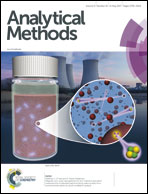Recent progress in the application of nanomaterials in the analysis of emerging chemical contaminants
Abstract
Emerging chemical contaminants (ECCs) represent newly identified chemical contaminants that are not yet covered by routine monitoring and regulatory programs. Current research into ECCs is greatly hindered by the shortage of analytical methods due to the complex sample matrices, extremely low environmental levels, and the “emerging” nature of ECCs. The use of nanomaterials (NMs) to solve the analytical problem of ECCs is a very active research field. We published an earlier review paper summarizing the application of nanomaterials in the analysis and monitoring of ECCs in 2014. In the subsequent years, this field has continued to rapidly develop with many new materials and technologies emerging. This paper therefore reviews recent progress in this field. Different types of NMs and analytical techniques are covered. Notably, we pay special attention to newly developed materials, such as metal–organic frameworks (MOFs), upconversion materials, carbon dots, and titania (TiO2) nanoparticles. We also stress the progress in emerging techniques, such as surface-enhanced Raman spectroscopy (SERS) and laser desorption/ionization mass spectrometry (LDI-TOF MS). Finally, we discuss current challenges and future prospects in this field.



 Please wait while we load your content...
Please wait while we load your content...